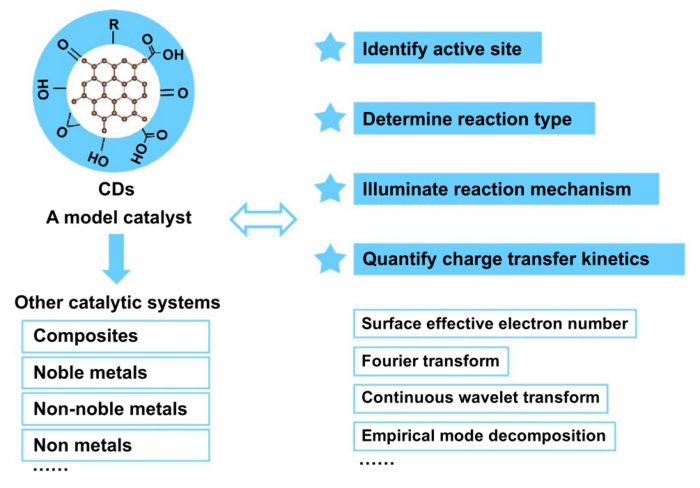Reviewed by Mila PereraSep 22 2022
A group of researchers headed by Professor Zhenhui Kang from Soochow University introduced the synthesis, structural features, and photoelectric chemical composition of carbon dots (CDs) and their uses in photocatalytic conversion.

Carbon dots (CDs) can be used as a good model catalyst for the TPV testing system, and a variety of data processing methods can be used to achieve in-depth research on the active site, reaction type, reaction mechanism, charge transport kinetic process, and other aspects. Image Credit: Yunjie Zhou, Fan Liao, Yang Liu and Zhenhui Kang
A new method of photocatalytic process characterization, transient photo-induced voltage/current (TPC/TPV), in the catalytic system of CDs is also discussed in the study.
The exclusive benefits and significant prospect of CDs in clean energy conversion and storage cannot be overlooked. Photoelectrocatalysis also has a highly multifaceted interfacial process, making it challenging to study the mechanism in-depth.
The current characterization technologies easily gain steady-state data in the photoelectrocatalysis process, but it is hard to reflect the variation during the reaction procedure.
Prof. Kang’s article presented a new technique of in-situ analysis and kinetic characterization, with CDs as an outstanding model.
TPV technology was used to gather and examine the dynamic process influenced by CDs in the photoelectrocatalytic process. The article was published in the International Journal of Extreme Manufacturing.
As innovative non-contact detection technologies, TPV/TPC has been designed to identify and explore the charge transfer kinetics, which can perceptively reflect the intricate electron separation and convey behavior in photo-/electro-catalysts.
By merging the rotating electrode method with the transient photovoltage response, a process model for the dynamic method of photoelectron directional extraction and photocatalytic forcing in situ is established.
The basic notion involved in the technique depends on the directional charge movement in reaction to photovoltage.
Using the water decomposition reaction as an example, the number of electrons shifted in the photocatalytic half-reaction can be attained in situ by transient light-induced current variations in the disk/ring electrode.
Data gathered with a temporal resolution of 50 nanoseconds by pointing a 4 nanoseconds pulsed laser onto the sample can give detailed information on charge transfer, recombination processes, storage, and photocharge-based catalytic reactions. The whole representation encompasses reaction times from microseconds to seconds.
By comparing the factors like curve shape, integrated area, maximum intensity time, maximum intensity, and decay constant, the kinetics of interfacial electron conveyance and reaction kinetics of in situ catalytic procedures can be attained directly and indirectly.
The photoelectric response information can help establish the catalytic active area, catalytic center, and reactant features and can be used to discover new features of catalytic materials surpassing expectations.
CDs may not represent the most efficient catalysts, but they bring a revolutionary understanding on catalytic mechanism and catalyst design principle. The TPV technology may not represent the most advance and universal techniques, but it brings a new and specific information on electron transfer kinetics for catalytic mechanism and catalyst design.
Zhenhui Kang, Professor, Soochow University
Journal Reference
Zhou, Y., et al. (2022) The advanced multi-functional carbon dots in photoelectrochemistry based energy conversion. International Journal of Extreme Manufacturing. doi.org/10.1088/2631-7990/ac8e3a.